
Azerbaijan, often called the “Land of Fire,” boasts a fascinating blend of ancient and modern influences, reflected in its rich most beautiful historical sites that attract tourists.
Here are the top 10 most beautiful historical sites that offer tourists a deep dive into the country’s vibrant past:
1. Maiden Tower (Qız Qalası), Baku Azerbaijan:
2. Gobustan National Park Azerbaijan:
3. Palace of the Shirvanshahs, Baku Azerbaijan:
4. Ateshgah Fire Temple, Surakhani Azerbaijan:
5. Sheki Khan’s Palace, Sheki Azerbaijan:
6. Quba Mass Grave Azerbaijan:
7. Albanian Church, Kish Azerbaijan:
8. Lahij Village Azerbaijan:
9. Nakhchivan Mausoleum Azerbaijan:
10. Shamakhi Juma Mosque Azerbaijan:
1. Maiden Tower (Qız Qalası), Baku Azerbaija:
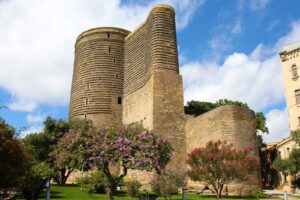
The Maiden Tower, or Qız Qalası, stands as an iconic historical monument situated in the heart of Baku, Azerbaijan.
This cylindrical stone tower, rising to a height of approximately 29.5 meters (97 feet), stands proudly within the ancient walls of the Old City, also known as Icherisheher, a UNESCO World Heritage site.
Mystery and legend shroud the origins of the Maiden Tower.
While the exact date of its construction remains debated, it is generally believed to have been built in the 12th century, with some parts possibly dating back to earlier periods.
The tower’s architectural style is a unique blend of Persian, Arabic, and Ottoman influences, reflecting the region’s diverse cultural heritage.
The Maiden Tower is constructed from limestone and, moreover, features a distinctive spiral staircase leading to the top.
The interior includes several floors with narrow windows, offering breathtaking views of the Caspian Sea and the modern cityscape of Baku.
The tower’s name, “Qız Qalası,” translates to “Maiden Tower” in English, and it is linked to numerous legends. One popular tale speaks of a king who wanted to marry his daughter.
In order to escape this fate, the maiden requested her father to build a tall tower, from which she ultimately leaped to her death.
Historically, the Maiden Tower served various purposes; initially as a defensive fortress, later as a watchtower, and eventually as a lighthouse.
In the present day, it houses a museum that, in addition, showcases the rich history and cultural significance of Baku and the broader region.
Visitors can explore its historical exhibits and ascend to the top for a panoramic view of the city.
2. Gobustan National Park Azerbaija:

Gobustan National Park, a UNESCO World Heritage site located about 64 kilometers southwest of Baku, is a fascinating destination for tourists interested in history, archaeology, and natural beauty.
Experts and visitors alike recognize this unique park for its extensive collection of rock engravings, providing a window into the lives of prehistoric humans.
With over 6,000 petroglyphs dating back 40,000 years, Gobustan is consequently one of the world’s richest ancient rock art sites.
These petroglyphs depict scenes of hunting, dancing, rituals, and daily activities, providing invaluable insights into the social and cultural practices of early human societies.
Visitors can experience an immersive journey through time by exploring the rock carvings spread across various rock shelters, caves, and boulders in Gobustan.
In addition to the petroglyphs, the park is home to ancient mud volcanoes and gas stones, adding to the unique geological landscape of the area.
Additionally, the Gobustan Museum, located near the entrance of the park, is an excellent starting point for visitors.
The museum features interactive displays, artifacts, and detailed explanations about the history and significance of rock art and the geological features of the region. It provides context and enhances the overall experience of exploring the park.
One of the highlights of visiting Gobustan is the chance to see the mud volcanoes, among the most active in the world.
These natural phenomena are not only intriguing but also offer a stark contrast to the arid landscape of the region.
Gobustan National Park is one of the historical sites that offers a unique blend of natural wonders and historical treasures; consequently, it is a must-visit destination for tourists traveling to Azerbaijan.
The park’s well-preserved petroglyphs and striking landscapes provide a captivating glimpse into the distant past, ensuring an unforgettable experience for all who visit.
3. Palace of the Shirvanshahs, Baku Azerbaija:
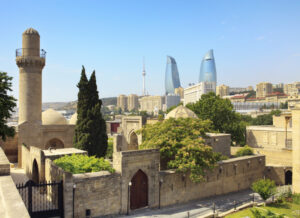
The Palace of the Shirvanshahs, located in the heart of Baku’s Old City (Icherisheher), is a magnificent architectural gem and a testament to Azerbaijan’s rich medieval history.
Constructed in the 15th century during the reign of the Shirvanshah dynasty, this palace complex is considered one of the finest examples of the Shirvan-Apsheron architectural style.
As you step into the palace grounds, you’ll be transported back to the height of the Shirvanshah dynasty’s power and influence; therefore, immersing yourself in its historical grandeur.
The complex includes the main palace building, a mosque, a mausoleum, the Diwan Khan (reception hall), the burial vaults, and the remnants of a bathhouse.
Each structure showcases intricate stone carvings, elaborate decorations, and a sophisticated design reflecting the advanced architectural techniques of the time.
One of the highlights of the palace is the Divan Khane, an octagonal pavilion used for ceremonial purposes.
Its ornate arches and delicate stone latticework are particularly striking. The Shirvanshah’s Mosque, with its beautifully carved mihrab (prayer niche), adds a spiritual dimension to the complex.
The mausoleum, also known as the tomb of the Shirvanshahs, houses the resting places of several members of the royal family.
The stone tombstones and the tranquil atmosphere provide a poignant reminder of the dynasty’s historical significance.
Visitors can also explore the palace museum, which offers a collection of artifacts, including ceramics, coins, and manuscripts, that provide further insight into the cultural and historical context of the period.
Informative displays and exhibits, moreover, help narrate the story of the Shirvanshahs and their contributions to Azerbaijani heritage.
The Palace of Shirvan Shahs is one of the historical sites, with its historical significance and architectural grandeur, providing tourists with a rich experience, highlighting the splendor and sophistication of medieval Azerbaijan.
4. Ateshgah Fire Temple, Surakhani Azerbaija:
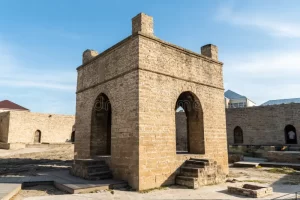
Located in Surkhani Azerbaijan, a suburb of Baku, Atashgah Fire Temple is unique and one of those interesting historical sites that attract tourists with an interesting blend of spirituality, history, and natural phenomena.
Known as the “Fire Temple of Baku,” Ateshgah is a testament to Azerbaijan’s ancient connection with fire worship, a significant aspect of Zoroastrianism and Hinduism.
Constructed in the 17th century, the temple is built on a natural gas vent, where flames have burned for centuries; thus, adding to its mystical and historical allure.
The complex features a central altar surrounded by a pentagonal courtyard; furthermore, this courtyard is encircled by a series of small cells.
These cells once housed pilgrims and ascetics who traveled from distant lands, drawn by the temple’s eternal flames.
Visitors entering the temple are greeted by the sight of the central altar’s ever-burning flame, a symbol of the divine for many of its historical worshippers.
The courtyard cells now serve as small museums, each detailing different aspects of the temple’s history, the religious practices of its devotees, and the significance of fire worship.
One of the most compelling aspects of Ateshgah is its multicultural history.
Inscriptions in Persian, Sanskrit, and Punjabi attest to the diverse origins of the pilgrims who once visited this sacred site. The temple’s architecture reflects this blend of influences, combining elements typical of Persian and Indian design.
The informative exhibits provide insight into the rituals and beliefs of the temple’s Zoroastrian, Hindu, and Sikh visitors, offering a comprehensive understanding of its spiritual significance.
Additionally, the Ateshgah Fire Temple’s serene and contemplative atmosphere provides a stark contrast to the bustling energy of modern Baku.
5. Sheki Khan’s Palace, Sheki Azerbaijan:
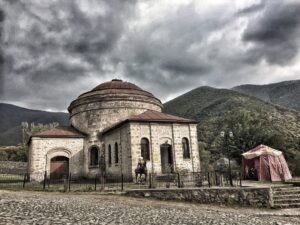
Tourists can explore Sheki Khan’s Palace in Sheki, Azerbaijan, which is one of the historical sites and is a journey into the heart of Caucasian history and architecture.
Nestled in the lush foothills of the Greater Caucasus Mountains, the palace is an exquisite example of 18th-century Islamic architecture, renowned for its stunning stained glass windows, intricate frescoes, and vibrant tile work.
As you approach the palace, the lush greenery and serene atmosphere set the tone for a truly enchanting experience; consequently, visitors are immediately captivated by the beauty and tranquility of the surroundings.
Its creators built the palace itself as a two-story structure without the use of nails; thus, showcasing their exceptional craftsmanship and ingenuity in construction techniques.
The façade is adorned with colorful shebeke (stained glass) windows, which cast a mesmerizing play of light and color into the interior rooms.
Inside, the palace is a feast for the eyes.
Each room, decorated with intricate patterns, hunting scenes, floral motifs, and geometric designs, creates a visually stunning, culturally rich environment for visitors to explore and appreciate.
The second floor houses the most impressive spaces, including the grand reception hall, where the khans once entertained guests.
Elaborate paintings and stained glass adorn the walls and ceilings here; consequently, they create a kaleidoscope of colors and patterns.
A visit to Sheki Khan’s Palace is not just about the visual splendor.
It is also an opportunity to delve into the rich history of the Sheki Khanate and its significance in the region.
The palace stands as a symbol of the area’s cultural heritage and its blend of Persian, Ottoman, and local influences.
Tourists can also explore the surrounding Sheki city, which is equally charming with its cobblestone streets, traditional houses, and vibrant bazaars.
6. Quba Mass Grave Azerbaijan:
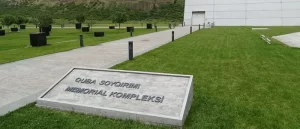
Visiting the Quba Mass Grave in Azerbaijan is a profound and somber experience, offering tourists a poignant insight into a tragic chapter of the region’s history.
Located in the Quba region, this site serves as a stark reminder of the atrocities committed during the early 20th century, specifically the massacre of civilians during the Armenian-Azerbaijani conflict in 1918.
As you arrive at the site, the serene surroundings provide a stark contrast to the heavy historical significance of the location.
During construction work in 2007, workers discovered the mass grave and have since turned it into a memorial complex to honor the victims.
The site includes a museum that provides detailed information about the events leading to the massacre; furthermore, it covers the discovery of the graves and the efforts to identify and memorialize the victims, offering visitors a comprehensive understanding of the tragic events that unfolded.
The museum’s exhibits include photographs, personal belongings of the victims, and other artifacts that paint a vivid picture of the tragic events.
Interactive displays and informative panels help visitors understand the broader historical context and the impact of the massacre on the local population and the region’s history.
A visit to the Quba Mass Grave is not only a history lesson but also an opportunity to reflect on the consequences of ethnic conflict and the importance of remembrance and reconciliation.
The respectful and educational presentation of the site ensures that visitors leave with a deeper understanding of the human cost of war and the importance of fostering peace and mutual understanding.
While in Quba, tourists can also explore the region’s natural beauty, including its lush forests, picturesque villages, and the stunning Qechresh forest.
7. Albanian Church, Kish Azerbaijan:
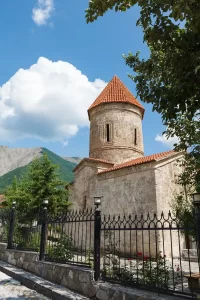
8. Lahij Village Azerbaijan:
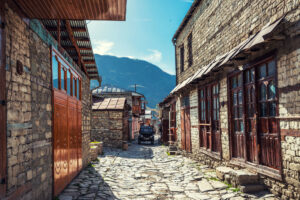
Visiting Lahij Village in Azerbaijan, one of the historical sites offers tourists a unique glimpse into the country’s rich cultural heritage and traditional crafts.
The preserved cobblestone streets, ancient architecture, and vibrant artisanal community have made Lahij, nestled in the Ismailli region high in the mountains of the Greater Caucasus, renowned.
The journey to Lahij is an adventure in itself, with winding roads that provide breathtaking views of the surrounding landscape.
Upon arrival, the village’s charming atmosphere greets visitors.
The narrow streets, stone houses with wooden balconies, and intricate lattice windows create a picturesque setting that feels like stepping back in time.
Lahij is famous for its skilled craftsmen, particularly coppersmiths, who have been practicing their trade for centuries.
Tourists can wander through the village’s workshops, watch artisans at work, and perhaps even purchase unique, handcrafted items as souvenirs.
The clang of a hammer on metal and the sight of artisans shaping molten copper into beautiful utensils and ornaments mesmerize visitors.
The village also boasts a rich history, with ancient mosques, bathhouses, and a sophisticated sewage system that dates back over a millennium.
In addition, the local museum offers insights into Lahij’s past, showcasing artifacts and exhibits that tell the story of the village and its people.
Visitors can enjoy traditional Azerbaijani hospitality in one of the local teahouses or guesthouses, savoring regional dishes and engaging with the friendly residents.
The surrounding nature also provides ample opportunities for hiking and exploring, with scenic trails leading to stunning viewpoints and secluded spots.
Lahij Village is a must-visit destination for those interested in history, culture, and traditional craftsmanship.
It offers a serene escape from the modern world, immersing visitors in the timeless beauty and heritage of Azerbaijan.
9. Nakhchivan Mausoleum Azerbaijan:
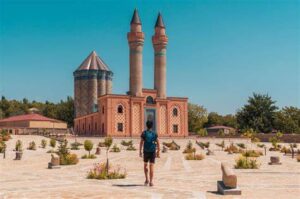
Visiting the Nakhchivan Mausoleum in Azerbaijan is a journey into the heart of ancient history and architectural splendor.
Located in the city of Nakhchivan, this mausoleum, also known as the Momine Khatun Mausoleum, stands as a testament to the rich cultural heritage of the region.
Constructed in the 12th century by architect Ajami Nakhchivani, the mausoleum is an outstanding example of medieval Islamic architecture; thus, it showcases intricate design and craftsmanship.
As you approach the site, the ten-sided structure, adorned with intricate geometric patterns and Kufic inscriptions, immediately captures your attention.
The mausoleum’s brickwork, combined with turquoise tiles, creates a striking visual appeal that is both elegant and timeless.
Inside, the mausoleum continues to impress with its intricate design.
Elaborate carvings and tilework cover the interior walls, showcasing the artistic achievements of the period; thus, providing a glimpse into the skilled craftsmanship and cultural significance of the era.
The builders constructed the mausoleum to honor Momine Khatun, the wife of the Atabeg ruler Shams ad-Din Eldiguz, and it stands as a symbol of enduring love and respect.
A visit to the Nakhchivan Mausoleum provides tourists with more than just a view of an architectural marvel.
It offers a deep dive into the historical and cultural context of the medieval Islamic world. Informative plaques and guided tours provide insights into the construction techniques, artistic influences, and historical significance of the site.
The city of Nakhchivan itself is rich in history and culture, offering additional attractions such as the ancient Nakhchivan Fortress, the Ashabi-Kahf cave, and the Alinja Castle.
Exploring these sites, in addition to the Nakhchivan Mausoleum, gives visitors a comprehensive understanding of the region’s historical narrative.
10. Shamakhi Juma Mosque Azerbaijan:
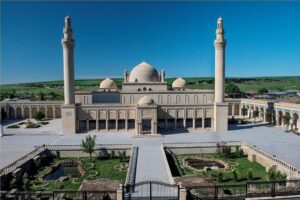
The Shamakhi Juma Mosque in Azerbaijan stands as a testament to the rich architectural and cultural heritage of the region.
Shamakhi Juma Mosque in Azerbaijan is one of the historical sites and holds significant religious and historical importance for the local community and tourists alike.
Constructed in the 8th century, the Shamakhi Juma Mosque is one of the oldest mosques in Azerbaijan, showcasing a blend of Islamic architectural styles that have evolved over centuries.
The mosque’s design features intricate geometric patterns, ornate calligraphy, and stunning domes that reflect the craftsmanship and artistry of the builders.
One of the most striking features of the Shamakhi Juma Mosque is its minaret, which towers over the surrounding landscape and serves as a focal point for the faithful during a call to prayer.
Colorful tiles, intricate mosaics, and beautiful stained glass windows adorn the mosque’s interior, creating a serene and spiritual atmosphere for worshippers.
Throughout its long history, the Shamakhi Juma Mosque has weathered various challenges; nevertheless, it has stood resilient as a symbol of faith and resilience.
Today, the mosque continues to be a place of worship, community gatherings, and cultural events, welcoming visitors from around the world to experience its beauty and significance.
In conclusion, the Shamakhi Juma Mosque in Azerbaijan is not just a place of worship but a living testament to the enduring legacy of Islamic architecture and culture in the region.
Its timeless beauty and historical significance make it a must-visit destination for those seeking to explore the rich heritage of Azerbaijan.






